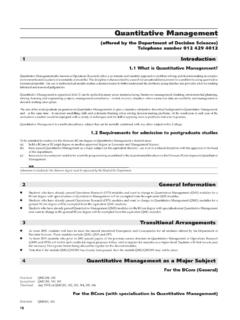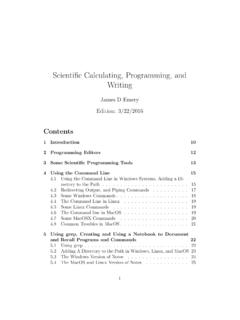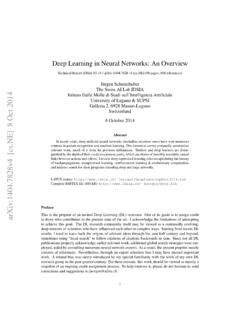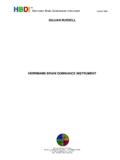Transcription of computer science - Every day matters
1 computer scienceAN OVERVIEWThis page intentionally left blank AN overview computer scienceJ. Glenn Brookshearwith contributions fromDavid T. SmithIndiana University of PennsylvaniaDennis BrylowMarquette University11th EditionAddison-WesleyBoston Columbus Indianapolis New York San Francisco Upper Saddle RiverAmsterdam Cape Town Dubai London Madrid Milan Munich Paris Montr al TorontoDelhi Mexico City S o Paulo Sydney Hong Kong Seoul Singapore Taipei TokyoEditorial Director:Marcia HortonEditor-in-Chief:Michael Hirsch Editorial Assistant:Stephanie Sellinger Vice President of Marketing:Patrice JonesMarketing Manager:Yezan Alayan Marketing Coordinator:Kathryn FerrantiVice President, Production:Vince O BrienManaging Editor:Jeff HolcombProduction Project Manager:Kayla Smith-TarboxSenior Operations Supervisor:Lisa McDowellArt Directors:Jayne Conte and Kristine CarneyCover Designer:Rachael CroninCover Image.
2 Slot Canyon gettyimages Inc. RF Media Editor:Dan Sandin and WandaRockwellProject Management:GEX Publishing ServicesComposition and Illustration:GEX PublishingServicesPrinter/Binder:Edwards BrothersCover Printer:Lehigh-PhoenixColor/HagerstownCr editsFigure : An abacus . Wayne Chandler. Figure : The Mark I computer . Courtesy ofIBM corporate archives. Unauthorized use is not permitted. Figure : A photograph of a viralworld produced by using 3D graphics (from Toy Storyby Walt Disney/Pixar Animation Studios) Disney/Pixar. Figure : A scene from Shrek 2by Dreamworks SKG. Dreamworks/Picture Desk collection. Figure : Results of using a neural network to classifypixels in an image. Inspired by Chapter 11, Robots Making History feature: a. A soccer robot kicks a ball during the RoboCup German Open 2010 on April 15, 2010in Magdeburg, eastern Germany.
3 Jens Schlueter/AFP/ Getty Images/ Newscom. b. TartanRacing s Boss winner of the Urban Challenge, a contest sponsored by DARPA to have vehiclesdrive themselves an urban environment. DARPA. c. One of NASA s rovers a robot geologistexploring the surface of Mars. Courtesy of 2012, 2009, 2007, 2005, 2003 Pearson Education, Inc., publishing as Addison-Wesley. All rights reserved. Manufactured in the United States of America. This publication isprotected by Copyright, and permission should be obtained from the publisher prior to anyprohibited reproduction, storage in a retrieval system, or transmission in any form or by anymeans, electronic, mechanical, photocopying, recording, or likewise. To obtain permission(s)to use material from this work, please submit a written request to Pearson Education, Inc.,Permissions Department, 501 Boylston Street, Suite 900, Boston, Massachusetts of the designations by manufacturers and sellers to distinguish their products areclaimed as trademarks.
4 Where those designations appear in this book, and the publisher wasaware of a trademark claim, the designations have been printed in initial caps or all of Congress Catologing-in-Publication Data available upon 9 8 7 6 5 4 3 2 1 EB 14 13 12 11 10 ISBN 10: 0-13-256903-5 ISBN 13: 978-0-13-256903-3vThis book presents an introductory survey of computer science . It explores thebreadth of the subject while including enough depth to convey an honest appre-ciation for the topics wrote this text for students of computer science as well as students fromother disciplines. As for computer science students, most begin their studieswith the illusion that computer science is programming, Web browsing, andInternet file sharing since that is essentially all they have seen. Yet computerscience is much more than this.
5 In turn, beginning computer science stu-dents need exposure to the breadth of the subject in which they are planningto major. Providing this exposure is the theme of this book. It gives studentsan overview of computer science a foundation from which they can appreci-ate the relevance and interrelationships of future courses in the field. Thissurvey approach is, in fact, the model used for introductory courses in thenatural broad background is also what students from other disciplines need ifthey are to relate to the technical society in which they live. A computer sciencecourse for this audience should provide a practical, realistic understanding of theentire field rather than merely an introduction to using the Internet or trainingin the use of some popular software packages. There is, of course, a proper placefor training, but this text is about educating.
6 Thus, while writing this text, maintaining accessibility for nontechnical stu-dents was a major goal. The result is that previous editions have been used suc-cessfully in courses for students over a wide range of disciplines and educationallevels, ranging from high school to graduate courses. This eleventh edition isdesigned to continue that in the Eleventh EditionThe underlying theme during the development of this eleventh edition was toupdate the text to include handheld mobile devices, in particular , you will find that the text has been modified, and at times expanded, toprefacepresent the relationship between the subject matter being discussed and smart-phone technology. Specific topics include: Smartphone hardware The distinction between 3G and 4G networks Smartphone operating systems Smartphone software development The human/smartphone interfaceThese additions are most noticeable in Chapters 3 (Operating Systems) and4 (Networking) but is also observable in Chapters 6 (Programming Languages),and 7 (Software Engineering).
7 Other prominent changes to this edition include updates to the followingtopics: Software ownership and liability: The material in Chapter 7 (Software Engineering) pertaining to this topic has been rewritten and updated. Training artificial neural networks: This material, in Chapter 11 (ArtificialIntelligence), has been , you will find that the material throughout the text has been updatedto reflect the state of today s technology. This is most prevalent in Chapter 0 (Introduction), Chapter 1 (Data Storage), and Chapter 2 (Data Manipulation).OrganizationThis text follows a bottom-up arrangement of subjects that progresses from theconcrete to the abstract an order that results in a sound pedagogical presentationin which each topic leads to the next. It begins with the fundamentals of informa-tion encoding, data storage, and computer architecture (Chapters 1 and 2); pro-gresses to the study of operating systems (Chapter 3) and computer networks(Chapter 4); investigates the topics of algorithms, programming languages, andsoftware development (Chapters 5 through 7); explores techniques for enhancingthe accessibility of information (Chapters 8 and 9); considers some major applica-tions of computer technology via graphics (Chapter 10) and artificial intelligence(Chapter 11); and closes with an introduction to the abstract theory of computa-tion (Chapter 12).
8 Although the text follows this natural progression, the individual chaptersand sections are surprisingly independent and can usually be read as isolatedunits or rearranged to form alternative sequences of study. Indeed, the book isoften used as a text for courses that cover the material in a variety of orders. Oneof these alternatives begins with material from Chapters 5 and 6 (Algorithms andProgramming Languages) and returns to the earlier chapters as desired. In con-trast, I know of one course that starts with the material on computability fromChapter 12. In still other cases the text has been used in senior capstone courses where it serves as merely a backbone from which to branch into projectsin different areas. Courses for less technically oriented audiences may want toconcentrate on Chapters 4 (Networking and the Internet), 9 (Database Systems),10 ( computer Graphics), and 11 (Artificial Intelligence).
9 On the opening page of each chapter, I have used asterisks to mark some sec-tions as optional. These are sections that cover topics of more specific interest orviPrefaceperhaps explore traditional topics in more depth. My intention is merely to pro-vide suggestions for alternative paths though the text. There are, of course, othershortcuts. In particular, if you are looking for a quick read, I suggest the follow-ing of data encoding and architecture and machine systems and the and algorithm of computationThere are several themes woven throughout the text. One is that computerscience is dynamic. The text repeatedly presents topics in a historical perspec-tive, discusses the current state of affairs, and indicates directions of theme is the role of abstraction and the way in which abstract tools areused to control complexity.
10 This theme is introduced in Chapter 0 and thenechoed in the context of operating system architecture, networking, algorithmdevelopment, programming language design, software engineering, data organi-zation, and computer InstructorsThere is more material in this text than can normally be covered in a singlesemester so do not hesitate to skip topics that do not fit your course objectives orto rearrange the order as you see fit. You will find that, although the text followsa plot, the topics are covered in a largely independent manner that allows you topick and choose as you desire. The book is designed to be used as a courseresource not as a course definition. I suggest encouraging students to read thematerial not explicitly included in your course. I think we underrate students ifwe assume that we have to explain everything in class.






